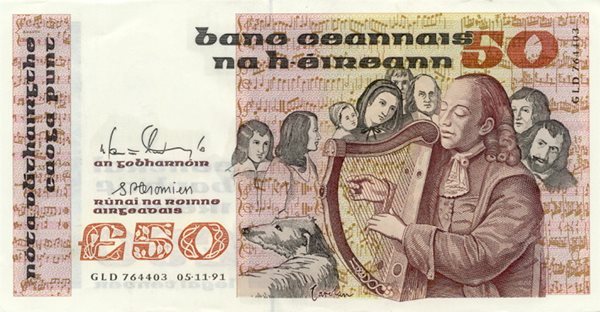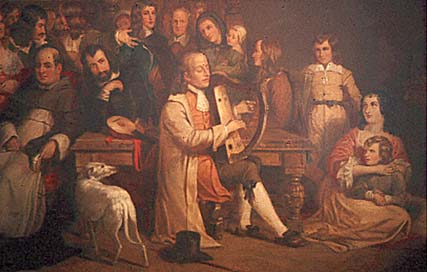late 17th century
O’Carolan’s Harp
A late 17th Century harp, stated to have belonged to Turlough O’Carolan, the Irish Bard.
Description
The Museum Register describes its physical attributes as, “Curved key piece bound on the front with an iron plate with one corner rivetted through the fore-pillar and two horizontal plates on either side rivetted on pillar, one binding it to the key piece.” The Royal Irish Academy register continues, “As in all Irish instruments of the same class, its strings, thirty-five in number, are of wire; the pins to which they are attached are of brass.”

How did it come to the Museum?
The harp was transferred from the Royal Irish Academy to the National Museum’s Irish Antiquities division in 1945, then onto the Art and Industry division in 1958.
Who was Turlough O’Carolan?
O’Carolan was an Irish harper, composer and singer. Born in Nobber, Co. Meath in 1670, he later moved with his parents to Co. Roscommon where his father was hired by the MacDermot Roe family. The newly married Mrs. MacDermot Roe took an interest in the young O’Carolan, and provided the means for his education. After he was blinded by smallpox at the age of eighteen, she continued her good efforts and arranged an apprenticeship for him with a harper also named MacDermot Roe. O’Carolan trained until he was twenty-one, after which he began his almost fifty year career as a travelling harper.

Widely regarded today as Ireland’s national composer, O’Carolan travelled the country with his horse and guide, arriving at the homes of his patrons to provide entertainment. He wrote poems, sang songs and played music like other harpers of his generation, but stood out and was most celebrated for his remarkable talents as a composer. He was often an honoured guest in the homes of wealthy patrons, and his compositions would generally reflect the family and/or the occasion that was being celebrated, such as a wedding or a funeral. The great Irish families opened their doors to him, and he enjoyed equality of status with the people for whom he performed. During his lifetime, he fathered seven children with his wife, Mary Maguire. He died in 1738, and is buried in Co. Roscommon.
Many of his tunes are still played today, and some compositions have been performed by popular artists such as Planxty, The Chieftains and The Dubliners.
The Irish Harp as a National Symbol
Ireland is distinctive in that it is the only country to have a musical instrument as its national symbol. From antiquity, the country has had a close association with the harp. Harpers are mentioned in legendary history, and from the 8th to the 10th century they appeared on stone high crosses. In 1534 under King Henry VIII, the harp was introduced on Anglo-Irish coinage. It was also used in the late 18th century as a political symbol. The United Irishmen adopted it as their official insignia in 1791 along with the motto, “It is new strung and shall be heard”. When the Irish Free State was born in 1922, the harp was taken as the emblem of this newfound independence. The image of the harp is now used on coins, passports, official seals and documents, as well as the seal of the President of Ireland.
With thanks to Jennifer Goff and Sandra Heise.
Learn more
This object is not on display as it is part of the Museum’s Reserve Collections. A harp and other musical instruments can be viewed in our Four Centuries of Furnishings exhibition at the National Museum of Ireland – Decorative Arts and History.
References:
- O’Sullivan, Donal. 1958. Carolan: The Life Times and Music of an Irish Harper. Ossian Publications Ltd. London.
- Boydell, Barra. 1995. The Iconography of the Irish Harp as a National Symbol. Four Courts Press.
- Armstrong, Robert Bruce. 1904. The Irish and the Highland Harp. Edinburgh.
Suíomh:
O’Carolan’s Harp suite ag:
In Storage
An déantán roimhe seo:
An chéad déantán eile:
Obsidian Arrowheads from Prehistoric Hokkaido
